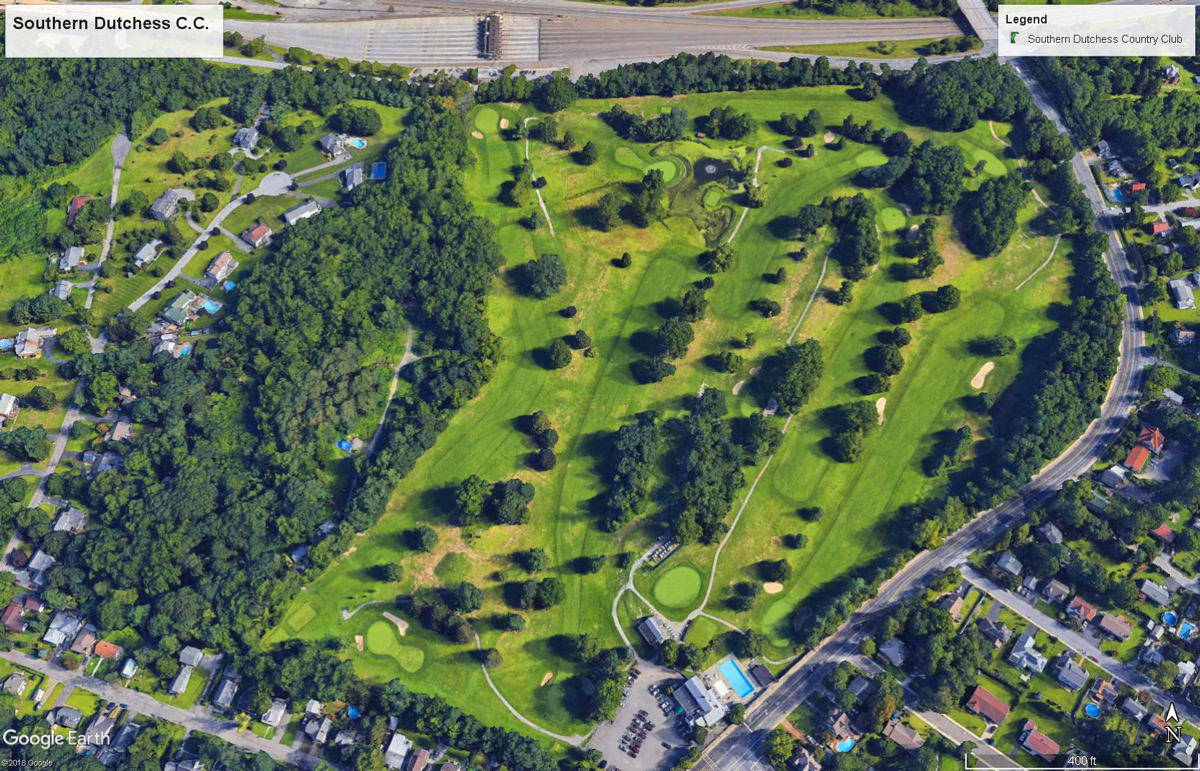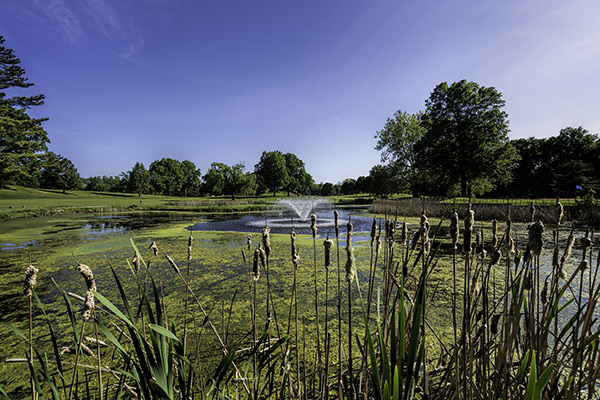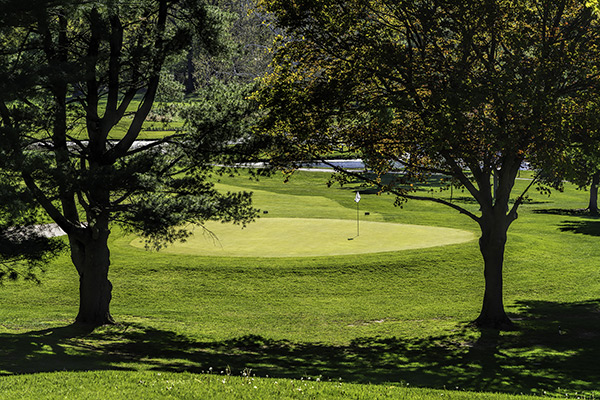As the Club was celebrating its 100th Anniversary in 2002, Ian MacDonald recorded a history of our golf course. Having been an SDCC Member since 1948 and caddying before he was old enough to become a Junior Member – and growing up in the house directly across the street from our 9th green – certainly qualifies Ian as having a good historical sense of how the course has evolved, not to mention a very good memory. What follows is Ian’s account, just as it was published in 2002.
“With the celebration of the 100th anniversary of the Southern Dutchess Country Club, it seems appropriate that the development of the golf course should be chronicled”.

Course Layout
“This is a brief history based upon personal recollections of this writer and others. Sadly, there is very little documentation available. Unfortunately, old photographs and scorecards have not been preserved. The end product is therefore flawed, but even so, the Club has an interesting history, worthy of some treatment.
In making references to traps and other landmarks on holes, left and right are from the tee facing the hole.
In the early years of the club only part of the approximately 50 acres were used for golf. With only five greens the players criss-crossed fairways. The first drawing provides a rough idea of what it was like. One must keep in mind that there were no trees separating what is now the first and ninth as well as the first and second fairways. It was wide open. It wasn’t until about 1940 that trees were planted between the first and the ninth. The trees between the first and second came later.
The back part of the property was opened up and developed after Harry “Pop” Vinall became pro around 1920. The course had a full nine holes which remained essentially the same until 1946 when significant changes started to take place.
In the late nineteen thirties, the course consisted of six par fours and three par threes. The only holes that have survived, although somewhat modified, are the first, second and eighth.
The first tee was originally at a spot in the back of the present ninth green which was built in the 1950s. It was started by Pro Mike Grande and finished and given its present shape when Harry Vinall, Jr. was the pro and his brother, Ralph Vinall, was the greenskeeper.
Sometime in the late 1920s or early 1930s, the tee was moved to its present location. That tee consisted of a large mound of earth about four to five feet high. The reason for the elevation was because of a hill approximately 50 yards off the tee, which was probably
the reason the tee wasn’t placed there in the beginning. The hill was blasted away around 1941 and the tee was lowered to its present level.
During the thirties and early forties there was a large mound with sand traps that traversed part of the first and ninth fairways about where the Sycamore tree now stands. The mound was removed sometime in the late nineteen forties.
While the first and second holes bear some resemblance to the course in the thirties and forties, the third has seen dramatic changes.
The third tee was on the side of the hill behind the present lady’s tee. It was reactivated when the present men’s tee was re-sodded about five or six years ago.
The present tee was located on top about 1947 or ‘48. The late Jinx Nolen was the member “architect” who oversaw the change but not without some controversy. Many thought that people on the second green would be at risk. While occasional shots do land in the area around the green, it has proven to be far less a risk than other places on the course.
The third green was located next to the large trap that guards the right side of the eighth fairway. When the present green was added in the ‘50s, both greens were used for a number of years, by alternating from one nine to the other. Eventually the old green was eliminated. There was a large tree in the left center of the fairway about 230 yards off the tee. The long hitters were able to get by it easily, but the shorter hitters had a problem. It was removed in the late ‘40s.
The fourth was originally a par four. The 150 yard marker sits in the middle of what was the green. There were traps on both sides in the front and one long shallow trap along the back. The original tee was the one closest to the third green. There were no ponds, only a small ditch directly in front of the tee and some swampy area to the right off the tee.
The fifth was a par three, about 150 yards with a tee behind the golf cart storage area and the green about 100 feet to the right of the present fifth green. The areas where the present fourth and fifth greens are located were wooded. These holes were added in the early Nineteen fifties.
The sixth was a par three approximately 150 yards long with a two tiered green. The tee was next to the trees by the work sheds and the green was next to the large tree on the right side of the present sixth fairway adjacent to the fifteenth tee. The sixth was made into a par five in 1947. The old sixth tee was move away from the trees to its present location. It is almost triple the size of the original. The fairway went to the right of the present over the ditch to a green adjacent to the present eighth tee.
The seventh was a par four approximately 380 yards. The tee was in front of the present fifteenth tee. The fairway followed what became the original par five sixth to the green next to the eighth tee.
The eighth is much the same as in the Thirties and Forties with some modifications. Trees along the right were added in the late Forties. The evergreens were added in more recent years. The trap on the right is the same, but the second hill going up to the green was steep with heavy rough. One could not pull a cart up it without a great deal of difficulty. The green was about half the size of the present with a trap in the back. To the left, and behind were heavy growth areas. The trap on the second hill is the same. There was a power line over the green that caused water to collect in one area of the green and was always depressed and difficult to cut.
The ninth was a par four of approximately 400 yards. The tee was to the right of the green used alternately now with the present ninth tee.
The ninth green was next to North Avenue to the left of the present ninth green. Part of the trap on the left side of the present green was on the right of the old ninth.
When the sixth and seventh were combined and made into the par five sixth, a new par three was added behind the eighth green. It was approximately 120 yards and was situate between the present eighth green and the present ninth tee. The tee was up to the left of the present eighth green to the left of the cart path. It was eliminated around 1964 when the State widened North Avenue with the opening of I-84 and the first Newburgh-Beacon Bridge. The present seventh was put in to replace it. The present sixth was also added at this time. It’s built on land acquired from the Verplancks around 1943. Joe Loffay was the Greens Chairman and claimed that the green was a copy of a green at the Winged Foot Golf Club in Mamaroneck.
Water
The fairway water system was installed in 1965. Before “water” the course was green for only about two to three weeks in June. The Tees would be closed for the first two or thee weeks in a season and by the middle of August in a dry year were mostly dust.


Rough
There was very little rough in the playing areas of the course, particularly between the fairways off the tees and around the greens. In the late 1940s, rough was allowed to grow between the first and ninth fairways. At first, the rough got pretty high and one day the late Jinx Nolen, a former champion, took two shots to get his ball back in play. He complained so much that some wag made a sign that said “Nolen’s Garden” and placed it in the middle of the rough. For years that area was known as “Nolen’s Garden”.
Winter at Southern Dutchess
Winter at the Country Club was a joy for neighborhood kids.
Sleigh riding and skiing were done on the “big hill” and “little hill”.
The big Hill was what is now the re-furbished ninth tee adjacent to the present eighth green. This was the ninth tee originally. There were no trees or shrubs on the slope toward the third green so it was ideal for sledding or skiing. An old Flexible Flyer could go almost to the fourth tee on a good run. The trap that guards the right side of the eighth fairway could be an unpleasant surprise if you didn’t steer to the left or right.
The “little hill” was in front of the first tee and was used by smaller children.
Three ponds provided good ice skating. There was one behind the second green that was partially filled in with rock and soil when the “little hill” was blasted away. The other two were really one. They were known as “Haights Pond” and the “Duck Pond.” They were located in the low area off the sixth fairway north of where the maintenance sheds are. They were filled in with material from the ponds on the fourth.
Sometime in the ‘30s, the stream along the ninth fairway was blocked at the culvert that goes under North Avenue. The area was then flooded for skating. It apparently damaged the fairway and was abandoned after one year”.